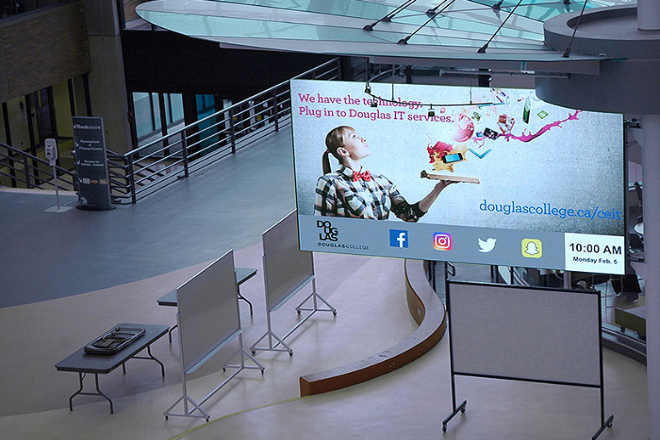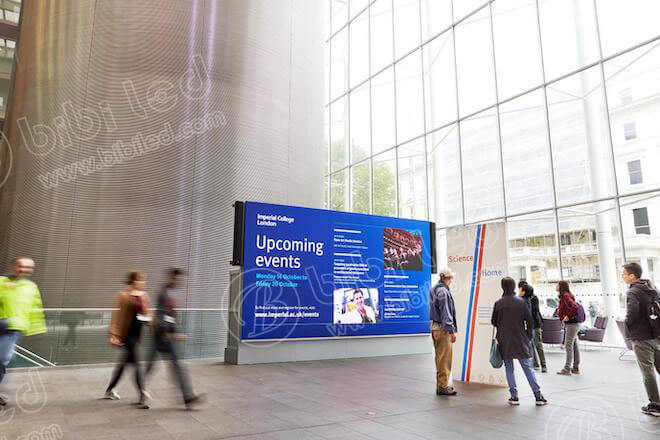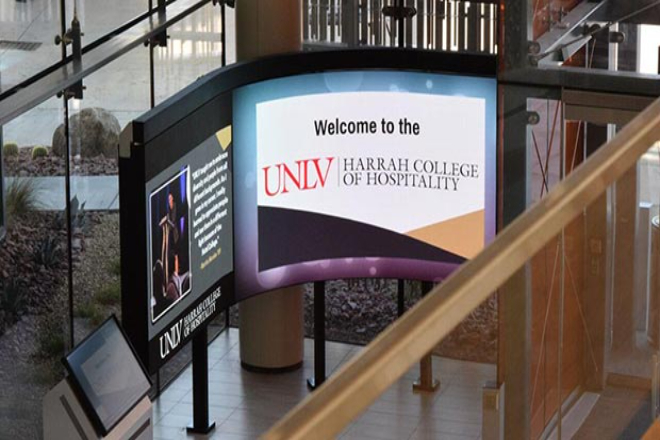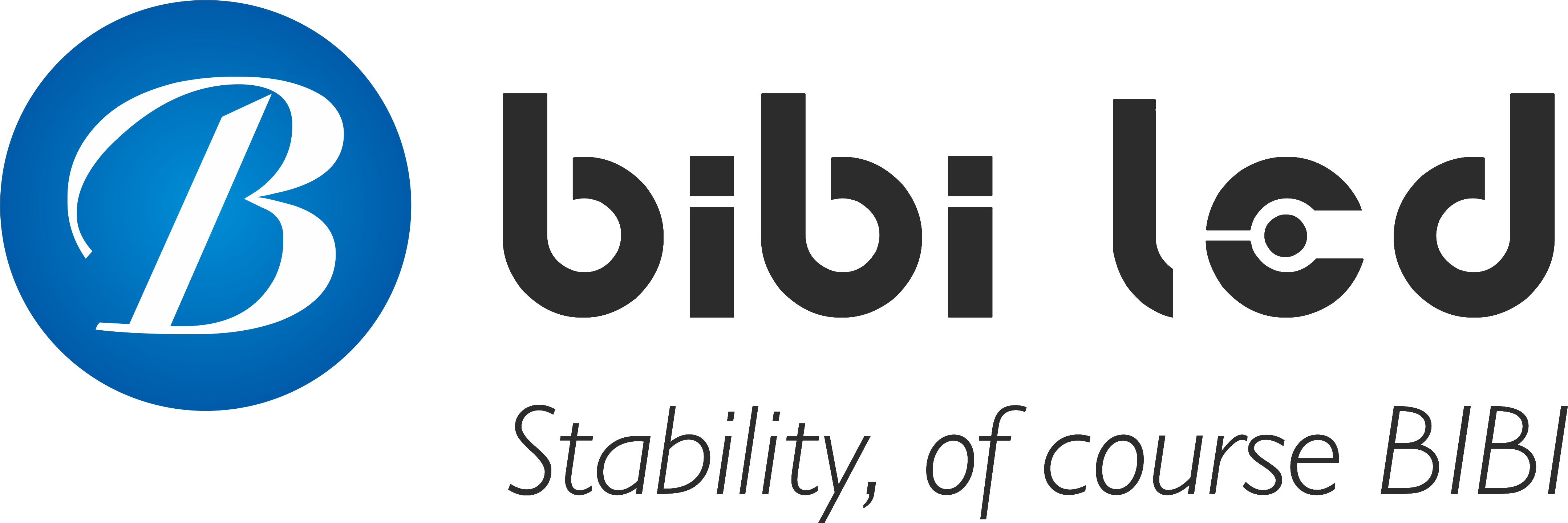소개
In university campuses, information is as ubiquitous as air, but how can this information be efficiently disseminated and truly reach teachers and students?
Traditional broadcasts, posters and bulletin boards seem to no longer meet the needs of modern campuses.
As an emerging communication tool, can 발광 다이오드 표시 스크린 become a “super assistant” for university information dissemination?
목차
1. Characteristics and needs of university information dissemination

1.1). Efficient information transmission
In universities, information is transmitted as fast as express delivery.
If there is an emergency, such as a temporary suspension of classes at school or a safety issue, teachers and students must be informed as soon as possible through various means, such as text messages, mobile phone applications, and broadcasts.
Otherwise, everyone will know nothing, and it will easily cause trouble. For that, routine information, such as course arrangements and academic activities, must also be released in a timely manner.
Otherwise, everyone may miss important things. Therefore, the school must have a useful information release platform to integrate various communication channels so that information can quickly “fly” to everyone’s hands.
1.2). Accurate information push
In universities, information cannot be sent randomly; it depends on the person. Just like recommending books to students, you have to see what type they like.
Science and engineering students may be more interested in scientific research projects and academic lectures, while liberal arts students may pay more attention to humanities and social science activities.
Therefore, the school must accurately push information to them according to their characteristics. Otherwise, there will be too much information, and it will be annoying for everyone to read.
Now, there are advanced technologies such as big data and artificial intelligence. Schools can use them to analyze the interests and needs of students and students and then push the most relevant information.
In this way, everyone can receive the information they really need, rather than a bunch of useless “spam.”
1.3). Convenient information acquisition
Information acquisition in college is as convenient as ordering takeout and can be found anytime and anywhere.
Now, everyone can’t live without mobile phones, so the information platform must be electronic and can be viewed with mobile phones anytime and anywhere.
This platform must integrate all kinds of information, including text, pictures, and videos, and it must be simple to operate and have a good interface; otherwise, it will be difficult for everyone to use, and they will not be willing to check the information.
In addition, the platform must have a useful search function. Just like finding something in a supermarket, teachers and students can quickly find the information they want through keywords, release time and other conditions.
In this way, everyone can easily obtain information and will not waste too much time looking for information.
1.4). Effective interactive communication
The information dissemination in the university should allow everyone to speak. Just like on social platforms, everyone can comment and like each other.
The school can build a campus forum or an online question-and-answer system so that teachers and students can communicate at any time.
For example, students can post questions on the forum, and teachers can reply when they see them; after listening to academic lectures, everyone can discuss their thoughts on the platform.
The school must also have a good feedback processing mechanism to collect everyone’s opinions, handle them seriously, and then tell everyone the results.
In this way, everyone will be more motivated, feel that they are valued, and can better participate in various activities of the school.
1.5). Long-term storage and query of information
Information in the university cannot be thrown away like expired snacks. Some information may still be useful after a while.
For example, when students review for the final exam, they may want to see the course schedule and teaching focus of this semester; when teachers write papers, they may need to refer to previous academic activity information.
Therefore, the information platform must have an archiving function to classify and save all the notifications and information that have been released.
Moreover, there must be a useful query function so that everyone can quickly find historical information through keywords, release time and other conditions.
In this way, everyone can review previous information at any time, and the school can also better manage and develop through these historical data.
2. Advantages of LED display screens in university information dissemination
Imagine that in the middle of the day, the sun is very bright, you are standing in the hall of the teaching building, and you look up. The words and pictures on the LED display screen are not dazzling at all but clear.
This is the power of LED display screens. It has high brightness and high contrast, so you can see it clearly at any time and under any lighting conditions.
For example, if the school organizes an event and puts the event posters and videos of wonderful moments on the LED screen, the visual effect will definitely catch the attention of teachers and students.
The best thing is that it can display everything: text, pictures, videos, and everything. Whatever you want to show, it can handle it.
In college, information is updated as frequently as changing clothes. Today, a course is adjusted, and an activity notification is issued. If the information is not updated in time, it will be troublesome.
LED display screens are simply amazing in this regard. It can update information in a flash through computers or other control devices.
For example, if the school suddenly has an emergency notice or the course schedule changes, the staff can move the mouse in the office to send the information to various LED screens on campus.
Moreover, this thing can be controlled remotely, and the staff does not have to go to the site to operate it.
The university campus is so large that if the information cannot be spread to every corner, it will be a waste of effort. LED display screens are simply “information dissemination experts” in this regard.
It can be installed in various key locations on campus, such as the lobby of the teaching building, the entrance of the library, the cafeteria, the dormitory area, etc.
These places are where teachers and students go every day, and the information can naturally be transmitted to everyone.
For example, when eating in the cafeteria, you can look up and see campus news and health tips on the LED screen.
Downstairs in the dormitory, you can see activity notifications and safety tips in the first place.
In this way, no matter where teachers and students are on campus, they can see important information in time.
Moreover, the number of LED screens can be increased at will, and they can be installed wherever they are needed to ensure that information is transmitted without dead ends.
Nowadays, everyone pays attention to environmental protection, and university campuses are no exception. LED display screens are really “little environmental protection guards” in this regard.
Compared with those old display devices, it is particularly energy-saving. Think about it: if a university campus is full of those power-consuming display screens, how much electricity would it cost?
Switching to LED display screens can immediately save a lot of electricity bills. Moreover, it is very clean to use, does not produce any harmful substances, and is very friendly to the environment.
The school uses this equipment not only to save money but also to create a green and environmentally friendly campus environment for teachers and students, killing two birds with one stone.
If the equipment on the university campus is old and broken, it will be troublesome. LED display screens are particularly reliable in this regard, and their service life is particularly long.
Although it may be a bit expensive when you buy it at first, it is very worry-free to use.
Generally speaking, an LED display screen can be used for many years, and you only need to do some simple maintenance during the period, and you don’t have to change the equipment all the time.
Moreover, it is very stable and rarely breaks down. The school uses this kind of display screen, which not only saves money on repairs but also saves a lot of trouble.
In the long run, this is very cost-effective and definitely a good helper for information dissemination on university campuses.
3. Layout and installation of LED display screens in universities

On university campuses, the layout and installation of LED display screens are big questions. If the layout is unreasonable and the installation is not in place, no matter how good the display screen is, it will not play its role.
1). Layout planning principles
First of all, you have to choose places where teachers and students go every day to install the display screen.
Just like the hall of the teaching building, the entrance of the library, the canteen, and the dormitory area, there is a large flow of people, and the information can cover more people.
If the display screen is installed in a remote corner, it would be a waste! Moreover, the installation location must be clear for teachers and students to see, and it cannot be blocked by anything, nor can it make teachers and students twist their necks and squint to see.
The height and angle of the display screen must be considered so that people can get information within a comfortable viewing angle.
In addition, the appearance design and installation method of the display screen must be in tune with the campus environment.
You can’t say that the quaint buildings on campus are so uncoordinated that you install a particularly abrupt display screen!
You can combine the architectural style and cultural atmosphere of the campus to give the display screen a personalized design so that it can be integrated into the campus landscape, and maybe it can become a landscape.
2). Installation strategies in different areas
In the teaching area, places such as the hall of the teaching building and the corridor of the classroom are the most suitable for installing display screens. Here you can display teaching information, course schedules, exam arrangements, etc.
You can install several small display screens on different floors and areas for teachers and students to view at any time. For example, when students are waiting for class in the corridor, they can check the course schedule by the way, how convenient!
The library area must also be arranged. Display screens are installed at the entrance, lobby or reading area of the library to publish the library’s opening hours, new book recommendations, academic lecture information, etc.
Moreover, the display screen can be connected to the library’s management system to display the collection information and borrowing status in real-time.
In this way, it is more convenient for teachers and students to find and borrow books.
The canteen area cannot be left behind. Display screens are installed at the entrance and dining area of the canteen to display the canteen’s menu, price, nutritional information, etc. At the same time, campus notices and event information can also be published.
After all, it is quite pleasant to look at this information while eating. However, the canteen environment is relatively noisy, and the volume and display effect of the display screen need to be optimized to ensure that the information can be clearly conveyed.
The dormitory area must also have a display screen.
Display screens are installed in places such as the lobby and corridor of the dormitory building to publish dormitory management regulations, water and electricity fee notices, campus event information, etc.
It would be even better if the touchscreen function could be set. Students can easily check personal information and campus resources, just like having an “information assistant” in the dormitory.
The public areas of the campus must be laid out with emphasis. Large display screens are installed on the main roads, squares, and gymnasiums of the campus to display major campus events, live sports events, emergency notices, etc.
These display screens are like “loudspeakers” on campus, which can enhance the cultural atmosphere and image of the campus and make the entire campus full of vitality.
3). Selection of display screen specifications and technical parameters
When choosing a display screen, you can’t be careless. You have to choose the appropriate display screen size and 해결 according to the size of the installation location and the 시거리.
For example, in large public areas with many people and large venues, you have to install a large display screen with high resolution to ensure the effect of long-distance viewing. In small indoor areas with limited space, choose a smaller display screen to save space and cost.
You also have to consider the 명도 and contrast of the display screen. If the display screen is outdoors, the sunlight is so strong, the brightness and contrast are not enough, then who can see the information clearly!
Therefore, the display screen installed outdoors must be high-brightness and high-contrast, so that information can be clearly displayed even under strong light.
The most important thing is to choose a display screen with reliable quality. No one wants the display screen to malfunction all the time and affect the dissemination of information. Therefore, you have to choose a display screen with high reliability and stability.
At the same time, you have to consider the protection level of the display screen, such as waterproof, dustproof, shockproof, etc., so that it can adapt to different installation environments.
For example, in a place with a lot of oil smoke, such as the cafeteria, the waterproof and dustproof function must be stronger.
4). Precautions during installation
During installation, safety is the top priority. You must ensure that the installation process complies with safety regulations and that there are no safety hazards for teachers, students and campus facilities.
Protective measures must be taken during the installation process, such as setting up warning signs and using safety equipment. Don’t hurt teachers and students by installing a display screen, which would be more trouble than gain.
It must also be connected to the campus network system. The display screen must be able to receive and update information normally, otherwise it will become a decoration.
At the same time, you must consider the network bandwidth and stability, and you cannot delay the information update due to network problems, which will affect the communication effect.
After the installation is completed, don’t rush to finish it. You must conduct sufficient testing and debugging to check whether the display effect, function operation, information update, etc., of the display screen are normal.
Only when you ensure that everything is in good condition can you put it into use with confidence? If problems are found, they should be solved in time to ensure that the display screen can work long-term and stably.
4. Design and production of information content of university LED display screens

1). Planning of information content
Before releasing information, you must first figure out why you want to release this information and who wants to see it. This is like knowing what dishes to cook and who to eat before cooking.
For example, teaching information must be practical and accurate, such as course schedules and exam times, so that teachers and students can understand them at a glance.
Academic activity information must be attractive, making people feel that this lecture or this scientific research project is interesting and worth going to. Campus notices must be simple and clear, and the key information must be made clear at once.
Moreover, the information must be classified and placed, just like the shelves in a supermarket, where teaching information, academic activities, and campus notices are arranged in different categories, making it easy for teachers and students to find them.
If the information is repeated, it will be like two rows of the same things in a supermarket, which is dazzling. Therefore, it must be integrated well, and the repeated content must be removed to make the information more useful.
In addition, the information must be updated frequently, just like the dishes must be changed frequently. Information with strong timeliness, such as course adjustments and emergency notices, must be updated quickly.
Long-term information, such as school rules and regulations and campus culture introductions, must also be checked regularly to ensure that they are not outdated or wrong.
2). Content classification and integration
Information is like a pile of messy threads, which must be classified and organized. Different information sections can be set up, such as the teaching information area, academic activity area, campus notification area, etc.
In this way, teachers and students can quickly find the information they need as soon as they see the display screen. For example, if students want to see the course schedule, they can go directly to the teaching information area to find it.
If they want to learn about academic lectures, they can go to the academic activity area. At the same time, attention should be paid to the integration of information to avoid repeatedly publishing the same or similar content.
For example, if the school rules and regulations have been published in the campus notification area, don’t repeat them in the teaching information area.
This can improve the utilization rate of information and make the content on the display screen more concise and organized.
3). Information update plan
Information should be updated as diligently as changing clothes, and the information on the display screen should not be outdated.
A reasonable information update plan should be formulated to ensure that the information on the display screen is always up to date.
For some information with strong timeliness, such as course adjustment, emergency notice, etc., it is necessary to publish and update it in time.
For example, if the school suddenly adjusts the course time, the new information must be sent to the display screen quickly.
Otherwise, the students will find that the course time has been changed when they go to the classroom. How troublesome!
For some long-term effective information, such as school rules and regulations, campus culture introduction, etc., regular inspection and maintenance can be carried out to ensure its accuracy and completeness, just like regularly checking the electrical appliances at home to see if there are any broken ones, repairing them, and replacing them.
4). Text content design
Text information is like writing an essay; it must be concise and clear. It cannot be written in a long and boring way, which makes people feel a headache when reading it.
Try to express the complete meaning in short language, highlight the key information, and allow teachers and students to quickly obtain the core content of the information in a short time.
For example, the exam notice is written as “Exam time: April 20, location: Classroom 101 of the teaching building”, which is simple and clear, and you can understand it at a glance.
At the same time, it is necessary to highlight the key points and attract the attention of teachers and students through font size, color, bold, etc.
For example, the key information of important notifications can be marked with large fonts and eye-catching colors so that the information “jumps” out on the display screen and people can see it at a glance.
In addition, the language must be standardized, without typos, grammatical errors, and ambiguous words.
For some professional terms or uncommon words, you can explain them appropriately, just like adding annotations to articles so that people who don’t understand can also understand them.
5. 결론
Through reasonable layout and carefully designed content, LED display screens can not only efficiently disseminate information on university campuses but also enhance the experience and sense of participation of teachers and students.
Although installation and maintenance require certain costs and technical support, in the long run, the convenience and value it brings far outweigh the investment.
마지막으로 LED 디스플레이 화면에 대해 더 알고 싶다면, 우리에게 연락해주세요.
